Guoqing Wang
Information Gain-based Policy Optimization: A Simple and Effective Approach for Multi-Turn LLM Agents
Oct 16, 2025Abstract:Large language model (LLM)-based agents are increasingly trained with reinforcement learning (RL) to enhance their ability to interact with external environments through tool use, particularly in search-based settings that require multi-turn reasoning and knowledge acquisition. However, existing approaches typically rely on outcome-based rewards that are only provided at the final answer. This reward sparsity becomes particularly problematic in multi-turn settings, where long trajectories exacerbate two critical issues: (i) advantage collapse, where all rollouts receive identical rewards and provide no useful learning signals, and (ii) lack of fine-grained credit assignment, where dependencies between turns are obscured, especially in long-horizon tasks. In this paper, we propose Information Gain-based Policy Optimization (IGPO), a simple yet effective RL framework that provides dense and intrinsic supervision for multi-turn agent training. IGPO models each interaction turn as an incremental process of acquiring information about the ground truth, and defines turn-level rewards as the marginal increase in the policy's probability of producing the correct answer. Unlike prior process-level reward approaches that depend on external reward models or costly Monte Carlo estimation, IGPO derives intrinsic rewards directly from the model's own belief updates. These intrinsic turn-level rewards are combined with outcome-level supervision to form dense reward trajectories. Extensive experiments on both in-domain and out-of-domain benchmarks demonstrate that IGPO consistently outperforms strong baselines in multi-turn scenarios, achieving higher accuracy and improved sample efficiency.
GeoPurify: A Data-Efficient Geometric Distillation Framework for Open-Vocabulary 3D Segmentation
Oct 02, 2025
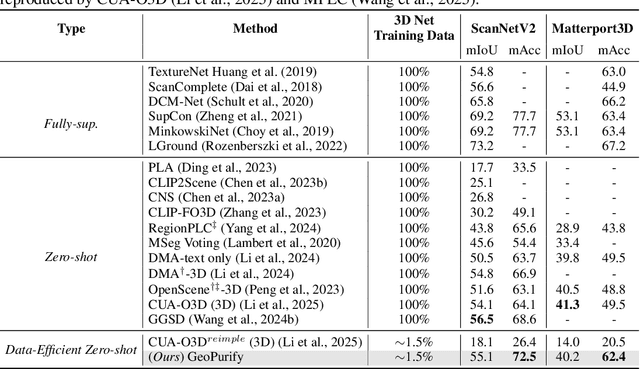
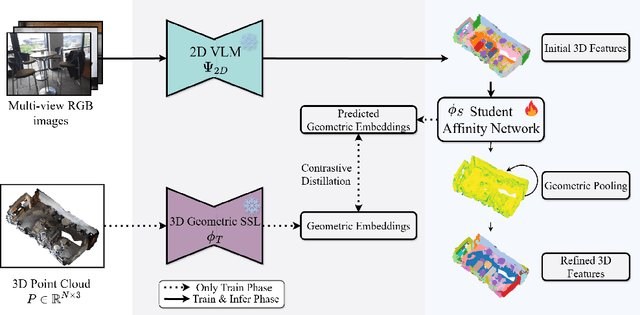

Abstract:Recent attempts to transfer features from 2D Vision-Language Models (VLMs) to 3D semantic segmentation expose a persistent trade-off. Directly projecting 2D features into 3D yields noisy and fragmented predictions, whereas enforcing geometric coherence necessitates costly training pipelines and large-scale annotated 3D data. We argue that this limitation stems from the dominant segmentation-and-matching paradigm, which fails to reconcile 2D semantics with 3D geometric structure. The geometric cues are not eliminated during the 2D-to-3D transfer but remain latent within the noisy and view-aggregated features. To exploit this property, we propose GeoPurify that applies a small Student Affinity Network to purify 2D VLM-generated 3D point features using geometric priors distilled from a 3D self-supervised teacher model. During inference, we devise a Geometry-Guided Pooling module to further denoise the point cloud and ensure the semantic and structural consistency. Benefiting from latent geometric information and the learned affinity network, GeoPurify effectively mitigates the trade-off and achieves superior data efficiency. Extensive experiments on major 3D benchmarks demonstrate that GeoPurify achieves or surpasses state-of-the-art performance while utilizing only about 1.5% of the training data. Our codes and checkpoints are available at [https://github.com/tj12323/GeoPurify](https://github.com/tj12323/GeoPurify).
Careful Queries, Credible Results: Teaching RAG Models Advanced Web Search Tools with Reinforcement Learning
Aug 11, 2025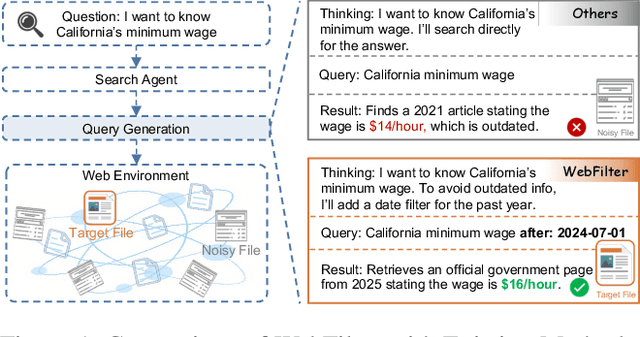

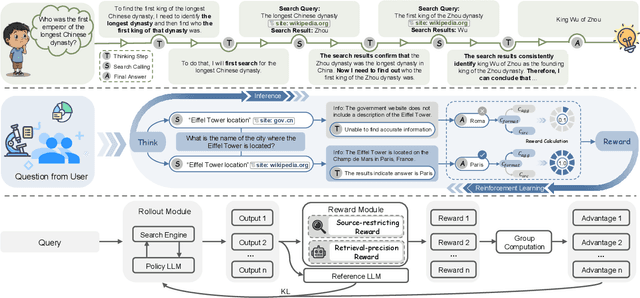
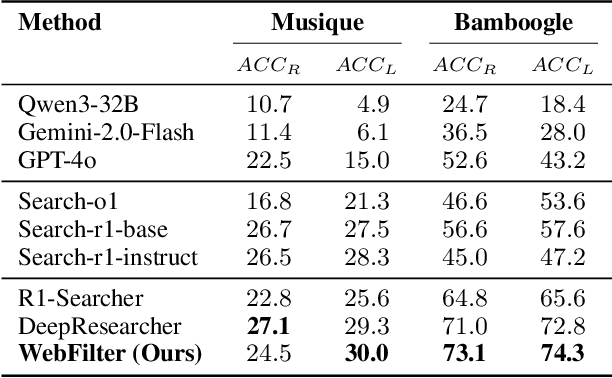
Abstract:Retrieval-Augmented Generation (RAG) enhances large language models (LLMs) by integrating up-to-date external knowledge, yet real-world web environments present unique challenges. These limitations manifest as two key challenges: pervasive misinformation in the web environment, which introduces unreliable or misleading content that can degrade retrieval accuracy, and the underutilization of web tools, which, if effectively employed, could enhance query precision and help mitigate this noise, ultimately improving the retrieval results in RAG systems. To address these issues, we propose WebFilter, a novel RAG framework that generates source-restricted queries and filters out unreliable content. This approach combines a retrieval filtering mechanism with a behavior- and outcome-driven reward strategy, optimizing both query formulation and retrieval outcomes. Extensive experiments demonstrate that WebFilter improves answer quality and retrieval precision, outperforming existing RAG methods on both in-domain and out-of-domain benchmarks.
Implicit Counterfactual Learning for Audio-Visual Segmentation
Jul 28, 2025Abstract:Audio-visual segmentation (AVS) aims to segment objects in videos based on audio cues. Existing AVS methods are primarily designed to enhance interaction efficiency but pay limited attention to modality representation discrepancies and imbalances. To overcome this, we propose the implicit counterfactual framework (ICF) to achieve unbiased cross-modal understanding. Due to the lack of semantics, heterogeneous representations may lead to erroneous matches, especially in complex scenes with ambiguous visual content or interference from multiple audio sources. We introduce the multi-granularity implicit text (MIT) involving video-, segment- and frame-level as the bridge to establish the modality-shared space, reducing modality gaps and providing prior guidance. Visual content carries more information and typically dominates, thereby marginalizing audio features in the decision-making. To mitigate knowledge preference, we propose the semantic counterfactual (SC) to learn orthogonal representations in the latent space, generating diverse counterfactual samples, thus avoiding biases introduced by complex functional designs and explicit modifications of text structures or attributes. We further formulate the collaborative distribution-aware contrastive learning (CDCL), incorporating factual-counterfactual and inter-modality contrasts to align representations, promoting cohesion and decoupling. Extensive experiments on three public datasets validate that the proposed method achieves state-of-the-art performance.
RealFactBench: A Benchmark for Evaluating Large Language Models in Real-World Fact-Checking
Jun 14, 2025Abstract:Large Language Models (LLMs) hold significant potential for advancing fact-checking by leveraging their capabilities in reasoning, evidence retrieval, and explanation generation. However, existing benchmarks fail to comprehensively evaluate LLMs and Multimodal Large Language Models (MLLMs) in realistic misinformation scenarios. To bridge this gap, we introduce RealFactBench, a comprehensive benchmark designed to assess the fact-checking capabilities of LLMs and MLLMs across diverse real-world tasks, including Knowledge Validation, Rumor Detection, and Event Verification. RealFactBench consists of 6K high-quality claims drawn from authoritative sources, encompassing multimodal content and diverse domains. Our evaluation framework further introduces the Unknown Rate (UnR) metric, enabling a more nuanced assessment of models' ability to handle uncertainty and balance between over-conservatism and over-confidence. Extensive experiments on 7 representative LLMs and 4 MLLMs reveal their limitations in real-world fact-checking and offer valuable insights for further research. RealFactBench is publicly available at https://github.com/kalendsyang/RealFactBench.git.
SemCORE: A Semantic-Enhanced Generative Cross-Modal Retrieval Framework with MLLMs
Apr 17, 2025Abstract:Cross-modal retrieval (CMR) is a fundamental task in multimedia research, focused on retrieving semantically relevant targets across different modalities. While traditional CMR methods match text and image via embedding-based similarity calculations, recent advancements in pre-trained generative models have established generative retrieval as a promising alternative. This paradigm assigns each target a unique identifier and leverages a generative model to directly predict identifiers corresponding to input queries without explicit indexing. Despite its great potential, current generative CMR approaches still face semantic information insufficiency in both identifier construction and generation processes. To address these limitations, we propose a novel unified Semantic-enhanced generative Cross-mOdal REtrieval framework (SemCORE), designed to unleash the semantic understanding capabilities in generative cross-modal retrieval task. Specifically, we first construct a Structured natural language IDentifier (SID) that effectively aligns target identifiers with generative models optimized for natural language comprehension and generation. Furthermore, we introduce a Generative Semantic Verification (GSV) strategy enabling fine-grained target discrimination. Additionally, to the best of our knowledge, SemCORE is the first framework to simultaneously consider both text-to-image and image-to-text retrieval tasks within generative cross-modal retrieval. Extensive experiments demonstrate that our framework outperforms state-of-the-art generative cross-modal retrieval methods. Notably, SemCORE achieves substantial improvements across benchmark datasets, with an average increase of 8.65 points in Recall@1 for text-to-image retrieval.
Syzygy of Thoughts: Improving LLM CoT with the Minimal Free Resolution
Apr 16, 2025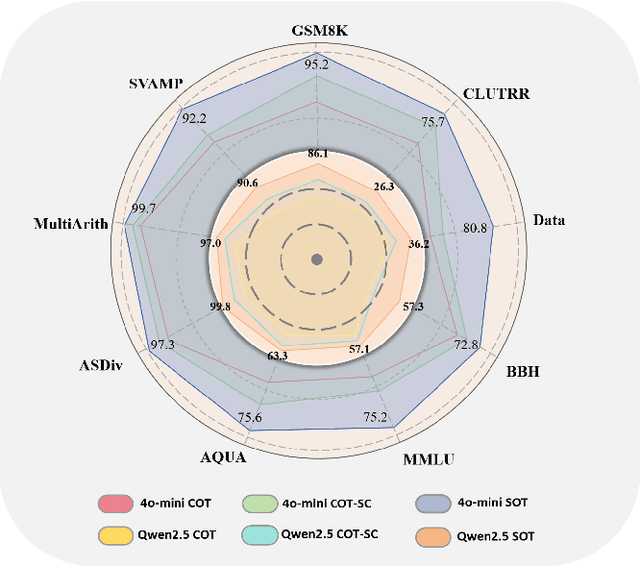
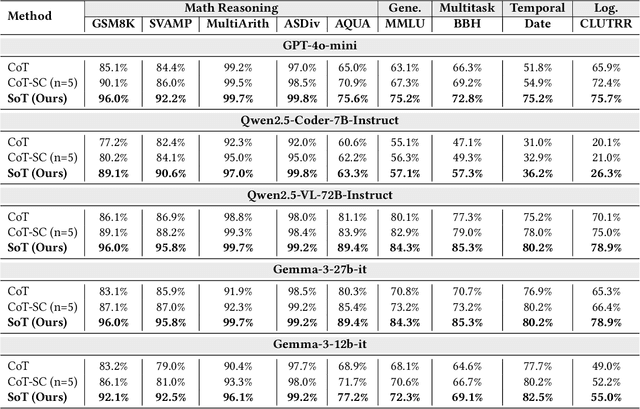
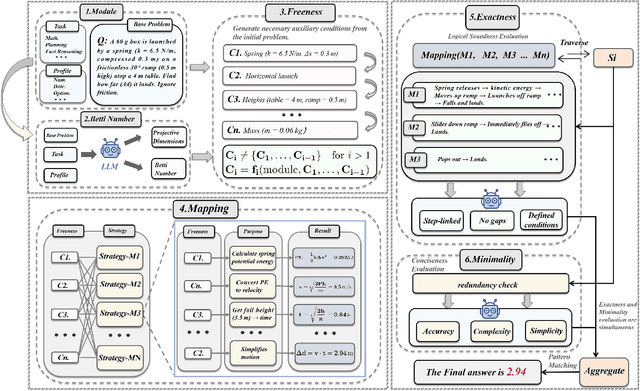

Abstract:Chain-of-Thought (CoT) prompting enhances the reasoning of large language models (LLMs) by decomposing problems into sequential steps, mimicking human logic and reducing errors. However, complex tasks with vast solution spaces and vague constraints often exceed the capacity of a single reasoning chain. Inspired by Minimal Free Resolution (MFR) in commutative algebra and algebraic geometry, we propose Syzygy of Thoughts (SoT)-a novel framework that extends CoT by introducing auxiliary, interrelated reasoning paths. SoT captures deeper logical dependencies, enabling more robust and structured problem-solving. MFR decomposes a module into a sequence of free modules with minimal rank, providing a structured analytical approach to complex systems. This method introduces the concepts of "Module", "Betti numbers","Freeness", "Mapping", "Exactness" and "Minimality", enabling the systematic decomposition of the original complex problem into logically complete minimal subproblems while preserving key problem features and reducing reasoning length. We tested SoT across diverse datasets (e.g., GSM8K, MATH) and models (e.g., GPT-4o-mini, Qwen2.5), achieving inference accuracy that matches or surpasses mainstream CoTs standards. Additionally, by aligning the sampling process with algebraic constraints, our approach enhances the scalability of inference time in LLMs, ensuring both transparent reasoning and high performance. Our code will be publicly available at https://github.com/dlMARiA/Syzygy-of-thoughts.
MSCRS: Multi-modal Semantic Graph Prompt Learning Framework for Conversational Recommender Systems
Apr 15, 2025Abstract:Conversational Recommender Systems (CRSs) aim to provide personalized recommendations by interacting with users through conversations. Most existing studies of CRS focus on extracting user preferences from conversational contexts. However, due to the short and sparse nature of conversational contexts, it is difficult to fully capture user preferences by conversational contexts only. We argue that multi-modal semantic information can enrich user preference expressions from diverse dimensions (e.g., a user preference for a certain movie may stem from its magnificent visual effects and compelling storyline). In this paper, we propose a multi-modal semantic graph prompt learning framework for CRS, named MSCRS. First, we extract textual and image features of items mentioned in the conversational contexts. Second, we capture higher-order semantic associations within different semantic modalities (collaborative, textual, and image) by constructing modality-specific graph structures. Finally, we propose an innovative integration of multi-modal semantic graphs with prompt learning, harnessing the power of large language models to comprehensively explore high-dimensional semantic relationships. Experimental results demonstrate that our proposed method significantly improves accuracy in item recommendation, as well as generates more natural and contextually relevant content in response generation. We have released the code and the expanded multi-modal CRS datasets to facilitate further exploration in related research\footnote{https://github.com/BIAOBIAO12138/MSCRS-main}.
DSPFusion: Image Fusion via Degradation and Semantic Dual-Prior Guidance
Mar 30, 2025Abstract:Existing fusion methods are tailored for high-quality images but struggle with degraded images captured under harsh circumstances, thus limiting the practical potential of image fusion. This work presents a \textbf{D}egradation and \textbf{S}emantic \textbf{P}rior dual-guided framework for degraded image \textbf{Fusion} (\textbf{DSPFusion}), utilizing degradation priors and high-quality scene semantic priors restored via diffusion models to guide both information recovery and fusion in a unified model. In specific, it first individually extracts modality-specific degradation priors, while jointly capturing comprehensive low-quality semantic priors. Subsequently, a diffusion model is developed to iteratively restore high-quality semantic priors in a compact latent space, enabling our method to be over $20 \times$ faster than mainstream diffusion model-based image fusion schemes. Finally, the degradation priors and high-quality semantic priors are employed to guide information enhancement and aggregation via the dual-prior guidance and prior-guided fusion modules. Extensive experiments demonstrate that DSPFusion mitigates most typical degradations while integrating complementary context with minimal computational cost, greatly broadening the application scope of image fusion.
Iterative Predictor-Critic Code Decoding for Real-World Image Dehazing
Mar 17, 2025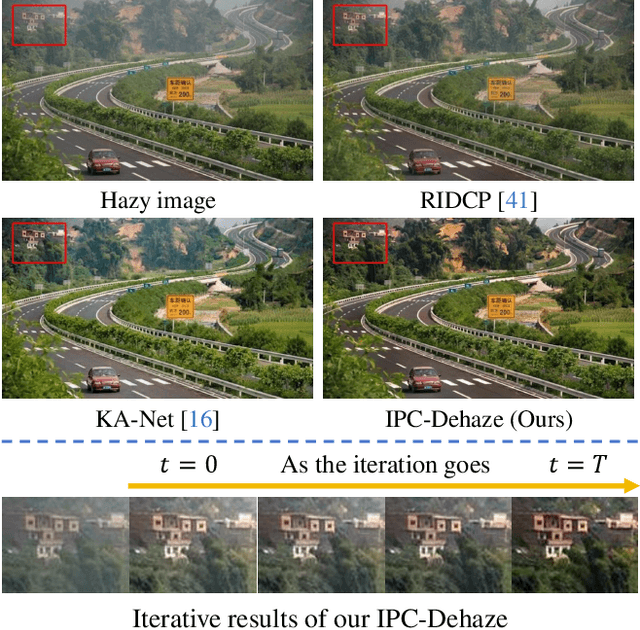
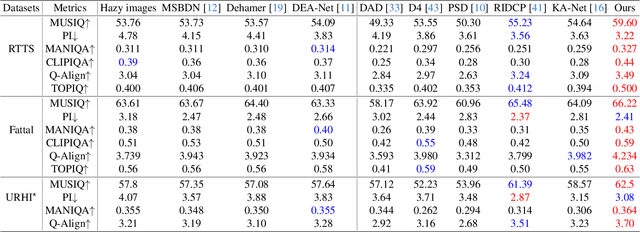
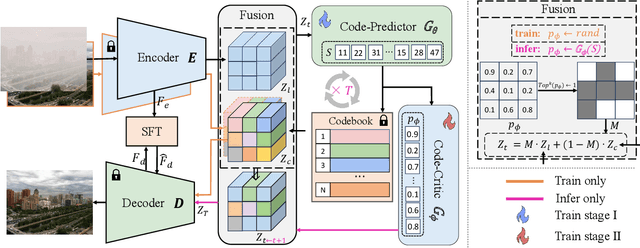

Abstract:We propose a novel Iterative Predictor-Critic Code Decoding framework for real-world image dehazing, abbreviated as IPC-Dehaze, which leverages the high-quality codebook prior encapsulated in a pre-trained VQGAN. Apart from previous codebook-based methods that rely on one-shot decoding, our method utilizes high-quality codes obtained in the previous iteration to guide the prediction of the Code-Predictor in the subsequent iteration, improving code prediction accuracy and ensuring stable dehazing performance. Our idea stems from the observations that 1) the degradation of hazy images varies with haze density and scene depth, and 2) clear regions play crucial cues in restoring dense haze regions. However, it is non-trivial to progressively refine the obtained codes in subsequent iterations, owing to the difficulty in determining which codes should be retained or replaced at each iteration. Another key insight of our study is to propose Code-Critic to capture interrelations among codes. The Code-Critic is used to evaluate code correlations and then resample a set of codes with the highest mask scores, i.e., a higher score indicates that the code is more likely to be rejected, which helps retain more accurate codes and predict difficult ones. Extensive experiments demonstrate the superiority of our method over state-of-the-art methods in real-world dehazing.
 Add to Chrome
Add to Chrome Add to Firefox
Add to Firefox Add to Edge
Add to Edge